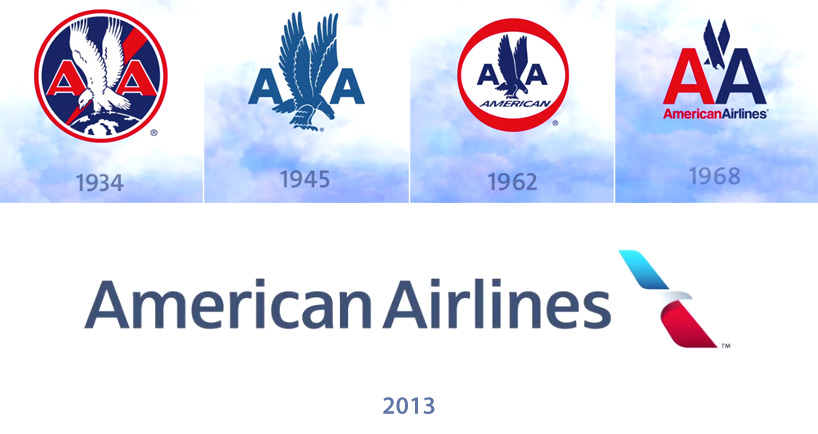Recently, at JFK airport I saw a jet carrying the old American Airlines logo, a stylized American eagle poised between red and blue capital Helvetica A’s.
New York based designer Massimo Vignelli (1931-2014) designed this identity in 1967, at a time when his sophisticated and sparse Modernist view of graphic design ruled the American corporate identity landscape. Vignelli’s motto was ‘Good design lasts longer.’
But does good design last longer?
Lets look at the rebranding of American Airlines, which shed its Vignelli designed identity of 45 years and opted for a sleeker new look in 2013. This new identity was created by Futurebrand, a global design agency that ‘defines and delivers future brand experiences.’ The rationale behind the rebranding of American Airlines (AA) can be found here.
Why was this iconic airline logo, created by one of America’s corporate identity giants, revamped? Since Vignelli first designed the logo in the 1960s, the global political and business environment has changed dramatically. The world is no longer dominated by opposing superpowers. Nationalities are not as sharply defined as they once were and the globe has contracted. Air travel is not a privilege anymore; on the contrary, it’s an absolute necessity in an age where everything hinges on our ability to get things done faster. Airfares are intensely competitive, with low-cost airlines and full service airlines vying for the same business. Additionally, disruptive technology has radically altered traditional business models.
American Airlines took on the challenges of this new economy, pulled itself out of bankruptcy and underwent a massive restructuring. It literally reinvented itself. AA needed to communicate this transformation to a new generation of air travellers. Its freshly minted identity is slim, in classic American blue and red with a ‘now you see it now you don’t’ eagle-like shape. This slim, forward-leaning form synergizes with the red and blue graphics on the aircraft tails and stands out in a sea of app icons on mobile screens. It works effectively across multiple touch points.
New York-based designer Massimo Vignelli (1931-2014) designed the old AA identity in 1967, the airline was rebranded in 2013, by Futurebrand

Branding today is about intimate conversations and personalized experiences
Monolithic brands and the larger-than-life designers like Vignelli who created them are now an anachronism. Branding today is about intimate conversations and personalized experiences. Visual identities are just a single facet of a company’s personality, the way its values manifest themselves in services and products are what define the brand. Businesses and services, from global corporations to the local mom and pop store, aspire to be unique. An army of creative people, ranging from freelance designers to global strategy firms now cater to the brand identity needs of businesses of different sizes.
With the proliferation of easy-to-use design software, crowdsourcing and a cross border work culture, it is now possible to get logo templates off the internet. In a scenario like this does it make sense to invest in professional design? Yes, it does!
The continued value of professional design
I am a graphic designer with over 3 decades of work experience in diverse business verticals in a world of rapidly altering technologies. Businesses, small or large have unique –and complex– needs. A one-size fits all template does not address issues specific to a particular business. I believe that professional branding firms help businesses identify their customer base with clarity. They create and constantly tweak the language that keeps customers engaged. Doing this is an ongoing process. Professional designers keep their ears to the ground all the time, since small, seemingly insignificant trends are sometimes harbingers of disproportionate change.
While working on the branding of the online jewellery store Jade & Jewels (J &J) at our consultancy Amplify, we first studied competing brands and products. We mapped the type of customer who would like J&J’s jewellery and wear it. An appropriate technology platform for e-commerce was identified. Our brand personality is faithful to the sophistication, passion –and underlying resilience–of the entrepreneur building this brand. Muted colour backgrounds to showcase products effectively and elegant fonts are used on the site. The ongoing social media plan is structured to reinforce these brand attributes. We are engaging with more and more customers everyday.
Whether it’s a mammoth global corporation like American Airlines or a small enterprise like Jade & Jewels, design needs to be acutely aware of the dynamic environment in which it functions and be truly sensitive to the needs of its target audience to remain relevant.
When this is kept in mind at all times, good design does last longer!
Deepa Kamath
Based in Hong Kong – mostly – Deepa travels the world and writes about what interests her and its influences on her design work.